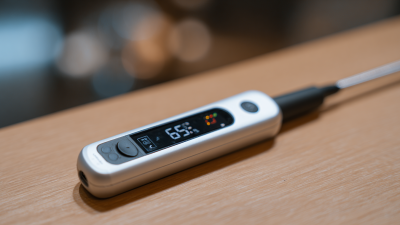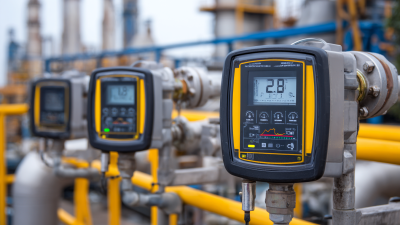7 Best Thermometer Sensors for Accurate Temperature Monitoring in Various Applications
In various industries, precise temperature monitoring has become crucial for ensuring safety, quality, and efficiency, underscored by reports indicating that the global thermometer sensor market is projected to reach $6 billion by 2027, growing at a CAGR of 6.5% (Mordor Intelligence). With applications ranging from food safety and storage to industrial processes and healthcare, the demand for reliable thermometer sensors is ever-increasing. Choosing the right thermometer sensor not only enhances data accuracy but also facilitates compliance with stringent regulatory standards.

This blog explores the seven best thermometer sensors tailored for specific applications, highlighting their features, advantages, and considerations for optimal performance in diverse environments. Whether you are in manufacturing, health services, or residential settings, selecting the right tool is fundamental for achieving precise temperature measurement and maintaining operational integrity.
Top Features to Look for in Thermometer Sensors for Precise Temperature Monitoring
When selecting thermometer sensors for accurate temperature monitoring, several key features should be prioritized to ensure precision and reliability in various applications. First and foremost, the sensor's accuracy and response time are critical. A high-accuracy sensor minimizes the margin of error, which is essential in settings like laboratories or food processing, where temperature extremes can affect outcomes. Furthermore, a fast response time ensures that temperature readings reflect real-time conditions, making it easier to take corrective actions as needed.
Another important feature to consider is the sensor's compatibility with different environments. Some thermometer sensors are designed to endure harsh conditions, such as high humidity or corrosive atmospheres, making them suitable for industrial applications. Additionally, versatility in temperature range can enhance a sensor's utility across multiple settings. For instance, sensors that can operate effectively in both low-temperature (refrigeration) and high-temperature (industrial processes) environments are highly valuable. Finally, integration capabilities with smart technologies and data logging features can further enhance monitoring efficiency, providing users with real-time data analysis and alert systems for more effective temperature management.
7 Best Thermometer Sensors for Accurate Temperature Monitoring
| Sensor Type | Temperature Range | Accuracy | Response Time | Ideal Applications |
|---|---|---|---|---|
| Thermocouple | -200°C to 1250°C | ±1.5°C | < 1 sec | Industrial, Science Labs |
| Thermistor | -50°C to 150°C | ±0.2°C | < 10 sec | Medical Devices, HVAC |
| Infrared Sensor | -50°C to 1000°C | ±2°C | < 0.5 sec | Food Industry, HVAC |
| RTD (Resistance Temperature Detector) | -200°C to 850°C | ±0.3°C | < 5 sec | Industrial Processing, Laboratory |
| Bimetallic Temperature Sensor | -40°C to 600°C | ±2°C | < 10 sec | HVAC, Home Appliances |
| Digital Temperature Sensor | -55°C to 125°C | ±0.5°C | < 1 sec | Consumer Electronics, Weather Stations |
| Thermal Imaging Sensor | -20°C to 1200°C | ±5°C | < 0.1 sec | Electrical Inspections, Building Inspections |
Essential Applications of Thermometer Sensors Across Different Industries
Temperature monitoring is crucial across various industries, ensuring the safety, quality, and efficiency of processes. In the food and beverage sector, for instance, the World Health Organization emphasizes maintaining food at safe temperatures to prevent foodborne illnesses. Reports show that nearly 600 million people fall ill each year due to contaminated food, underlining the need for advanced thermometer sensors that provide precise temperature readings to mitigate these risks.
In the healthcare industry, accurate temperature monitoring plays a vital role in patient care. According to a study by the American Journal of Infection Control, improper temperature management in medical settings can lead to complications and increased hospital stays. With the integration of digital thermometer sensors, healthcare professionals can swiftly and accurately detect changes in patient temperatures, thus improving response times and overall patient outcomes. Similarly, in the industrial sector, the American Society of Heating, Refrigerating and Air-Conditioning Engineers (ASHRAE) highlights that precise temperature control in manufacturing environments can enhance product quality and reduce waste, emphasizing the critical role of thermometer sensors in achieving operational excellence.
Comparative Analysis of Analog vs Digital Thermometer Sensors
When it comes to temperature monitoring, the choice between analog and digital thermometer sensors can significantly influence accuracy and usability in various applications. Analog thermometers typically utilize a liquid column or a bimetallic strip, relying on traditional methods to indicate temperature changes. While they are durable and do not require batteries, they can be prone to human error and may take longer to provide readings. In contrast, digital thermometers use electronic sensors to offer precise and immediate temperature readings, making them ideal for applications where accuracy is paramount, such as in medical or laboratory settings.
**Tip:** When selecting a thermometer, consider the specific needs of your application. If quick and accurate readings are essential, opt for digital sensors. Conversely, if you're working in a simple environment where ruggedness is more critical than precision, an analog thermometer may suffice.
Another factor to weigh is the ease of reading and data logging capabilities. Digital thermometers often come equipped with features such as backlit displays and data storage options, facilitating easier record-keeping and analysis. On the other hand, analog thermometers might require more manual interpretation, which can lead to inconsistencies if not handled carefully.
**Tip:** Look for digital models with connectivity features that allow integration with software for real-time monitoring and logging, enhancing the overall management of temperature-sensitive processes.

Innovative Technologies Driving the Future of Temperature Sensing Solutions
Innovative technologies are reshaping the landscape of temperature sensing solutions, facilitating precise and reliable monitoring across a multitude of applications. From industrial manufacturing to healthcare, the evolution of thermometer sensors has led to the development of cutting-edge devices that enhance accuracy and efficiency. Advanced materials, such as thermoelectric sensors and nanotechnology, are being integrated into modern thermometer designs, enabling quicker response times and greater sensitivity to temperature changes. This is particularly crucial in environments where temperature fluctuations can significantly affect outcomes, such as in laboratories or during food storage.
The rise of smart technology further propels the advancement of temperature sensing solutions. IoT-enabled sensors are now capable of not only measuring temperature but also transmitting data in real time, allowing for remote monitoring and control. Such innovations improve safety and operational efficiency, as users can receive alerts and respond proactively to any deviations in temperature. As industries increasingly embrace automation and data-driven decision-making, the demand for sophisticated thermometer sensors will continue to grow, paving the way for even more innovative solutions in the future.

Tips for Maintaining and Calibrating Your Thermometer Sensors for Optimal Performance
Maintaining and calibrating thermometer sensors is crucial for ensuring optimal performance, especially in industries where precise temperature measurements are essential. According to a report by the National Institute of Standards and Technology (NIST), inaccuracies in temperature readings can lead to significant financial losses, particularly in sectors like pharmaceuticals. The report highlights that temperature deviations of over 1°C can compromise the integrity of drug compounds, emphasizing the need for regular calibration to ensure that sensors meet industry standards.
To maintain the accuracy of thermometer sensors, regular checks and comprehensive calibration procedures should be established. A study published in the Journal of Calibration Science recommends calibrating sensors at least once a year, depending on their usage and environmental conditions. Additionally, the report suggests employing traceable calibration methods to ensure compliance with national metrology standards. Regular maintenance, including cleaning sensors and protecting them from dust and moisture, is also essential. This not only prolongs the lifespan of the sensors but also prevents drift in readings due to environmental factors. Such diligence can help organizations mitigate potential risks associated with temperature monitoring errors, thus enhancing overall operational efficiency.
Related Posts
-

Top Strategies for Enhancing Efficiency with Temperature Monitoring Sensors
-

Top Strategies for Maximizing Efficiency with Temperature Detectors
-

5 Essential Tips for Choosing the Right Temperature Sensor for Your Business Needs
-

How to Optimize Energy Consumption with Advanced Heat Flow Meter Technology
-

The Future of Enhanced Conductivity Measurement Techniques
-

7 Compelling Reasons Why a Soil Temperature Probe is Essential for Every Garden Enthusiast







